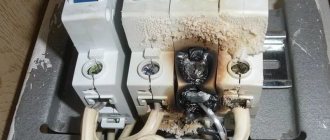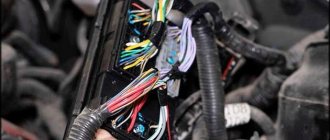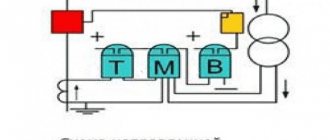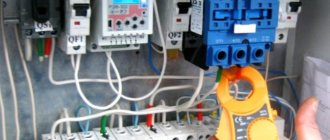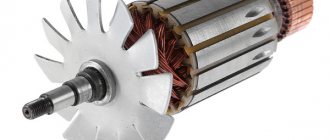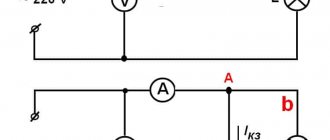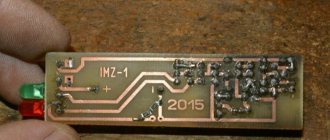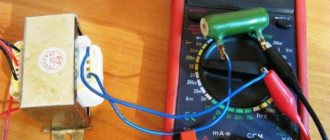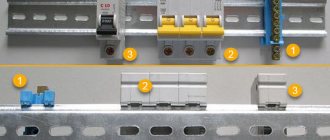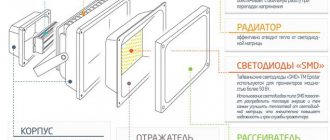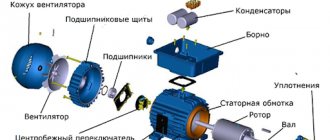What is a short circuit
A short circuit (SC) is an abnormal operation of the electrical network. It is characterized by a sharp jump in current up to hundreds and thousands of amperes. The voltage drops to almost zero. This process is short-lived and usually stops when the circuit breaker trips.
Electrical wiring fault
In an ordinary residential apartment or house, the most common phase conductor short circuit to neutral or ground. At enterprises and in various workshops, short circuits between linear conductors are also encountered. This type of closure is called interphase.
Methods of protection against short circuits
Let's consider such an important question: how to protect yourself from a short circuit? The answers are obvious and on the surface:
- It is necessary to use high-quality electrical equipment, cables with the appropriate cross-section and high-quality insulation (NYM, VVG).
- Entrust wiring installation only to people specially trained in electrical installations. Because knowledge of the existing norms and regulations in the energy sector is their direct duty and area of responsibility.
- For fire protection purposes and wiring protection in general, it is necessary to use short circuit protection devices: circuit breakers, RCDs, differential circuit breakers and various relays. It is also worth paying attention to a high-quality cable, with an appropriate cross-section and good insulation.
- We also recommend that all our clients, when installing new wiring, avoid junction boxes. Deep switches and sockets work great instead.
- Once a year you need to inspect all wiring: stretch contacts in panels, sockets, switches; remove dust from contacts and machines. These methods will not only save you from short circuits, but will also reduce the likelihood of fires.
Causes of short circuit in wiring
A short circuit does not occur out of the blue. There are always reasons and prerequisites. Some of them are easily predictable, obvious and on the surface. They can be identified many months before a short circuit occurs. Others arise instantly. They cannot be prevented in advance.
The main causes of short circuit are as follows:
- mains voltage surge;
- overheating and melting of insulation;
- aging and wear of wires;
- penetration of dust, dirt and moisture from the air;
- rodents, domestic and wild animals;
- lightning and atmospheric electricity;
- human error.
Wiring in old houses
Mains voltage surge
The standard mains voltage for the CIS countries is 220-230 volts. Rarely is this norm exceeded. The outlet has a voltage of 380 volts or higher. In this case, the protection devices at the substation or directly at the consumer must operate. However, they are not always in good condition and overvoltage “walks” along the wires.
A large potential difference leads to electrical breakdown of the insulation. The process starts with a small leakage current. Subsequently it increases. The breakdown site is heating up. Then the insulation at the point of damage finally loses its dielectric properties and a full short circuit occurs with the formation of an electric arc.
Power surge
Overheating and melting of insulation
Electric current flowing through a conductor leads to heating of the current-carrying conductors. If an acceptable power consumer is connected to the outlet, the cable temperature remains within normal limits. If the current exceeds the rated current, the wire overheats. Over time, the temperature reaches a value at which the insulation melts. The current-carrying conductors remain without a protective layer and touch each other freely. There is a bang, a flash and the short circuit is ready. If the circuit breaker trips, everything will be fine. If not, the wiring will heat up white and the insulation will burn until the circuit is completely broken.
The maximum permissible currents of residential electrical wiring are indicated in the table. The values may differ slightly depending on the installation method (open, in the wall, etc.)
| Wire cross-section, mm2 | Maximum permissible current, A | |
| Copper | Aluminum | |
| 1,5 | 15 | — |
| 2,5 | 21 | 16 |
| 6 | 34 | 24 |
Important! Attention should be paid to bolted wire connections and various terminal blocks. Their contacts are subject to loosening. A loose fastening will inevitably heat up and burn. Usually this problem is recognized by a crackling sound from the shield or a burning smell. The malfunction is typical for old, previously unmaintained equipment.
Aging and wear of wires
Any electrical wiring consists of current-carrying conductors and a layer of insulation. A metal conductor in normal operation can last indefinitely. Insulation is subject to wear and tear. The service life of the protective layer is affected by:
- cable load and temperature;
- laying conditions (open, closed);
- ambient temperature and humidity;
- mechanical stress and vibration;
- cable manufacturing quality.
Service life of wires and cables
Aluminum wires are designed for 15-20 years of service. Copper - 25-30. Then the insulation begins to age, crack and crumble. The conductors remain without a protective layer and are able to touch each other freely. The result will be a short circuit.
Penetration of dust, dirt and moisture from the air
This type of short circuit is common in residential panels and distribution devices. In these sections of the network, the wiring has exposed, non-insulated parts. Over time, dust from the air settles on them. When dry, it does not conduct current well. However, there is a certain percentage of moisture in the air.
Dust settles on terminal blocks, input circuit breakers and other components of the electrical panel. When the layer of dirt becomes thick enough, its resistance drops sharply and electrical breakdown occurs. Water entering the electrical panel can greatly aggravate the situation. For example, in the event of a pipe break or if the shield is located in the open air and is exposed to precipitation.
Rodents, domestic and wild animals
Pets and outdoor animals are often the culprits of short circuits. The four-legged one's teeth itch. The animal begins to chew on the insulation. Even if the pet receives an electric shock and weanes itself off this habit, the protective layer will remain damaged. Moisture will get into the hole in the insulation. This will most likely lead to a short circuit.
Rodents can cause a short circuit
In another case, the four-legged culprit is attracted to the heat coming from cables and busbars. The animal climbs into electrical assemblies, switchboards and switchgear cabinets, then looks for the warmest place. As a rule, these are electrical buses with a voltage of 0.4 kV.
Lightning and atmospheric electricity
Tall buildings, engineering structures, and power line supports are required to be equipped with grounding. One of its tasks is to attract lightning strikes and charges from the atmosphere for their further discharge into the ground.
A simple lightning protection system consists of an iron wire or strip connected between the roof of the building, the reinforcement and the ground. This is usually done for each entrance separately. If you exclude lightning protection, then the discharge can enter the household electrical network. It is not designed for high lightning currents and voltages. Upon impact, electrical breakdown of insulation will occur everywhere. There is a high risk of damage to the protective layer by high voltage and further development of the short circuit.
Lightning protection of a cottage roof
Human error
Even experienced electricians make mistakes. When wiring cables through an apartment network, a person can confuse the wires and connect the phase directly to zero or ground. This usually happens in room junction boxes.
If the phase wire is connected to the neutral wire, then when you try to supply voltage to the apartment, the circuit breaker will trip. Therefore, electrical installation work should be divided into several stages and the correct connection should be checked after each one.
Errors when installing electrical wiring
Negative impact of short circuit for a person and his property
A short circuit, depending on the location of its occurrence, leads to detrimental consequences for property and the safety of human life. These include:
- burning and failure of electrical appliances;
- ignition of electrical wiring;
- a decrease in the voltage of the electrical network (in industrial conditions it leads to a shutdown of enterprises);
- decrease in the efficiency of power supply systems;
- the occurrence of electromagnetic influence leads to disruption of the functioning of communications located underground.
Consequences of a short circuit
In the event of a short circuit, the circuit breaker must trip. This is usually what happens. And if not, then the wiring quickly overheats, melts and begins to burn. Therefore, short circuit is one of the most common causes of fire. A corresponding warning is also available on the website of the Ministry of Emergency Situations. According to this resource, every day in Russia 125 buildings burn down due to faulty wiring.
Fire due to shorted wiring
When it is not possible to find a short circuit
Sometimes it is simply impossible to find a short circuit . And in some cases, even a professional locator will not be able to help. You have to lay a new line, change machines or change the entire wiring . This usually happens due to unskilled electrical installation. For example, large bundles of various wires are hidden under a thick layer of mortar and walled up somewhere deep in the wall (or floor). Moreover, these twists serve as a so-called switching unit, from which wiring throughout the apartment diverges in all directions. On top you can add broken wire insulation and current spreading across the floors. Such miracles happen, and unfortunately for the owners of such repairs, it cannot be treated by any devices or electricians.
With certain skills, you can find a short circuit with your own hands, BUT it is better to save your nerves, save money and call a real electrician by phone. The cost of eliminating a short circuit includes the guarantee that there will no longer be a short circuit in that location.
Short Circuit Detection Techniques
If the circuit breaker has tripped, then the worst has been avoided. Then the question arises of how to find a short circuit in the apartment wiring. There is no need to panic. There is a chance that you will be able to detect the malfunction yourself without calling a specialist. Finding a short circuit in an apartment is divided into four simple steps:
- Visual inspection.
- Elimination method.
- Detection by sound and smell.
- Use of special measuring instruments.
Visual inspection
It is not a fact that the short circuit point is in the wall. Usually the fault lies on the surface. It can be seen with the naked eye and quickly eliminated.
Extension cords need to be inspected. Especially in places where the cable bends and the plug is connected. Often one wire comes loose and dangles in the air. A phase contact that is not secured by anything can touch the neutral contact and lead to a short circuit. Next are the sockets. Wires can also fall off and end up in the wrong place.
Visual inspection of electrical wiring in a private house
Elimination method
If a simple inspection does not help, you will have to move on to the elimination method. The main thing is to understand why the machine is triggered. It is worth remembering under what circumstances the short circuit occurred. If the embarrassment occurred at the moment when the iron was plugged into the socket, then the problem lies there. If not, you should turn off the household appliances one by one until the circuit breaker stops tripping.
If absolutely all devices are unplugged and the lights are turned off everywhere, then you will have to move on to the next stage. It is important to remember to check devices that are always plugged in (refrigerators, televisions).
Additional Information. You will never find a short circuit that is not there. Old circuit breakers are prone to false trips. That is, there is no short circuit in the wiring, and the machine lives its own life and turns off the apartment for no known reason. Before searching for a short circuit, it would not hurt to make sure that the protection devices are operating adequately and find out for sure why the circuit breaker trips.
Sound and smell detection
When a short circuit occurs, a lot of energy is released. She doesn't leave without a trace. Often in the problem area the wires heat up, the insulation melts, smoke is formed and there is a smell of burning. If the circuit is unstable, then when voltage is applied at the short circuit point, a bright flash with sparks and a bang will occur. Its intensity is such that it is almost impossible not to notice this phenomenon even in hidden wiring.
This and the previous methods require periodic re-switching of the voltage. This, in turn, will lead to a short circuit again. It is advisable to carry out such experiments a minimum number of times and with at least some knowledge and experience of such work. If possible, it is wiser to call a professional electrician. He will most likely come with a multimeter or megger.
Use of special measuring instruments
The method requires electrical engineering education. The closure point is sought using measuring instruments:
- multimeter;
- megohmmeter;
- indicator screwdriver;
These devices allow you to ring the apartment's electrical network and determine in which area there is a point with an abnormally low resistance between the phase and neutral (ground) conductors. The most effective way to find short circuits is a megohmmeter. But it is much safer to use a multimeter in diode testing mode. If a section of wiring with a short circuit is connected to its terminals, the device beeps.
Danger in the house
A malfunction, called a “shorty” in electricians’ slang, in a household network without a protective shutdown and with “bugs” instead of fuses, is fraught with serious consequences. Always causes material damage.
In a “safe” scenario, the wiring will burn out at the point of the short circuit, the electrical fittings will melt at the point of contact with metal parts, and the electrical equipment will fail.
In an extreme situation, if you do not turn off the power in time, a fire may occur in a private home. For example, an arc flash will ignite insulation or an electrical appliance, then the fire will spread to adjacent areas of the facility. This will lead to material losses with the consequences described in the reports of the Ministry of Emergency Situations.
Definition and physical justification for the occurrence of a malfunction:
A short circuit is the occurrence of electrical contact between two points in sections of an electrical circuit with different values of electrical potential, if such a connection is not provided for by the design of the device. Which leads to disruptions in work.
In contrast to a long circuit, which is the connection of electrical appliances to the network, a short circuit is a circuit closed along a short path, bypassing consumers. The power system of a facility, including a residential building, consists of electrical devices and linear elements for the passage of electric current to consumers from the input distribution device.
It ensures uninterrupted operation of power units, household appliances, heaters and lamps.
The supply of operating voltage to electrical receivers is provided by loops made of two-core and stranded wire. For wiring, conductors with copper or aluminum conductors in a dielectric sheath are used (rubber, polyvinyl chloride, fabric braiding are used).
In the normal state, conductors with different electrical potentials “phase” and “zero” do not interact; they are separated by a dielectric layer. If an electrical contact occurs in an emergency situation, the current immediately increases like an avalanche. This is due to the fact that the network represents an alternating voltage source U = 220 V or U = 380 V, the value of which practically does not change. Consequently, the current at a constant voltage is determined by the value of the resistance in the load Icz = U/Rcz, where the value of Rcz in the denominator is 0.
In accordance with the physical Joule-Lenz law, a flowing high current causes a significant release of heat, heating closed conductors to a temperature of 5000 °C.
If the circuit breaker does not operate, the heating may reach critical levels and cause a fire in the insulation or flammable materials in contact with the wiring.
Elimination of short circuit consequences
If the search for the short circuit was successful, then it’s time to exhale and start eliminating it. What to do next depends on the extent of the damage to the electrical wiring. Regardless of the situation, before starting any repair work, you should definitely turn off the power to the apartment and make sure there is no voltage.
It is necessary to assess how much the cable insulation was damaged at the time of the short circuit. If there are swelling, darkening or melting, the wire must be replaced. If possible, it is necessary to assess its condition along its entire length.
Connecting wires in the distribution box using terminal blocks
If the wire covering is in order, then the immediate location of the short circuit is removed. The surviving ends of the current-carrying conductors are stripped and connected using Wago terminal blocks, welding, soldering or crimping. In low-current circuits, you can use regular fast twisting at your own risk. However, the PUE (7th edition, clause 2.1.21) does not provide for and does not approve of this method of connecting cables.
Repair of damaged area
Repairing the damaged area is quite simple (see Do-it-yourself diagnostics and repair of electrical wiring). Although ideally a new wire should be installed, temporary repairs can be made to this area. To do this, it is important to use a wire with a cross-section no smaller than the existing one and made of the same material.
So:
- First of all, we will have to remove the layer of plaster under which the wiring is hidden. This should be done carefully so as not to damage it further.
- We make sure that we have correctly identified the location of the damage by the presence of a break or traces of a short circuit.
- We cut the damaged wire and connect to it a small insert made of wire of the same material. The connection is best done by soldering or pressing. This will significantly reduce the depth of the required niche for subsequent plastering of the wire.
Repair of damaged wires
- It is best to use heat shrink as insulation, which will be much easier to put on and which will again save space.
- After repairs, check the functionality of your network by applying voltage and turning on the load. If possible, apply a higher load and check that there is no increased heat at the joints. If everything is fine, you can plaster the niche with the wire.
- It is better to reapply voltage and put it into operation after the plaster has dried.
Preventive measures to prevent short circuits
Most short circuits and the fires they cause can be avoided. To do this, you should follow simple rules:
- Do not overload the electrical wiring with power (current). Select the cable cross-section and lay it in accordance with the requirements of the PUE.
- Periodically inspect the electrical panel, sockets and switches. The smell of burning, smoke, sparking and crackling are harbingers of a short circuit and fire.
- Replace old circuit breakers with new ones. Especially if a revision of the shield has not been carried out since Soviet times.
- If you use fusible plugs at the entrance to the apartment, then under no circumstances place so-called bugs on them. Even if an electrician I know “did this 100 times and everything was fine.” It is best to replace traffic jams with automatic machines.
If you notice that there is a burning smell coming from the electrical panel or switchgear, immediately notify the management company. The actions of the emergency service will be aimed at preventing short circuits and inspecting equipment.
A short circuit is one of those problems that are easier to prevent than to correct the consequences. Any wiring, various devices and panels require periodic inspection by a specialist. Compliance with this rule will ensure long and safe operation of electrical equipment.
If it was not possible to avoid a short circuit, then you need to think about its causes. Wiring that is old, too thin or damaged by animals must be replaced. Damp - dried and further tested by a professional electrician using a megger or more advanced instruments.
Ways to prevent
All protective measures to prevent short circuits are based on prevention and prevention, reducing the likelihood of an emergency. Such measures include:
- Installation of circuit breaker or fuses. The machine will turn off the power in time, regardless of the cause of the short circuit.
- Regular inspection of electrical wiring. Places of insulation melting can be seen visually and damaged conductors can be replaced in a timely manner.
- Before carrying out repair work, when you need to drill into walls, you need to use a special device to first determine the location of hidden wires.
- In bathrooms with high humidity, use electrical appliances to a minimum and, if possible, avoid them altogether.
It is impossible to completely guarantee that a short circuit will not occur, but preventive measures will help minimize risks.
Short circuit, methods for finding it
Consider the case where your fuse blows. There are several types of short circuit, in the first case your fuse burns out instantly, immediately after its installation in the fuse block or during a short period, in a matter of moments after installation, but not instantly. This means that in the first case, the conductor through which it goes “plus” has direct direct contact with the “ground” of the car body, this option is a little easier in troubleshooting. It is always more difficult to identify the cause of a malfunction when it is weak or spontaneous in nature, with a tendency to appear and disappear.
When searching for a short circuit, the most important thing is to determine in which part of the circuit the short circuit occurs. When searching, I recommend that you arm yourself with a test light, a long piece of wire, a book or an electrical diagram of the electrical equipment of your car. If your fuse blows, then the short circuit is located in the section of the circuit from the fuse block to the device that is powered by this fuse.
I wrote “if possible” because not all electricity consumers are easily accessible, and many are located in places where this procedure can only be performed by a specialist or a person who has already encountered this. For example: if you determine that you have a short circuit in the direction indicator or hazard warning circuit of a VAZ 2105 car, you will need to disconnect the plug from the hazard warning switch, which is located on the right side of the steering column; if, when you turn it off and install the fuse, the short circuit disappears, you need go further along the wiring, and the relay for the turn signals and hazard warning lights is located under the dashboard, which I do not advise you to remove alone if you have not had such experience.
Above, I advised you to use a test light and a piece of wire when searching, now I’ll explain why. How we defined a short circuit is when the wiring or some part of the device connects or has contact with the ground of the car, we make a circuit by connecting a long wire to the “plus” of the battery and a control light, however, it can just be a control light with one long part. When looking for a short circuit, you must have the battery disconnected, but in this case, you will need to completely disconnect everything from the positive, and the negative ground must be connected to the car.
We connect the second terminal of our test lamp to the fuse block, connect it to the place where this formed minus comes from, since when we insert a fuse, it immediately blows out, which means a minus is formed at one output, and a positive voltage is applied to the second, as expected.
When we connect a light bulb to this terminal, in the event of a short circuit, it will immediately light up brightly. Now, according to the scheme, we will turn off all electricity consumers that are powered by this fuse. And we will observe the behavior of the light bulb, how it burns, as soon as we disconnect the device causing the short circuit, the light bulb should either go out or shine dimmer, which will correspond to the fact that we have found the cause of the short circuit. No tags for this post.
What to do when the lights go out
When the lights suddenly go out in your apartment, you should first determine the cause of this phenomenon. In most cases, you can do without outside help. To do this, make sure of the following:
- Availability of lighting in all rooms. If it turns out that there is no light in the entire house and in nearby ones, then the reason is most likely not in the internal wiring, but in an accident in the power supply system;
- Presence of voltage in sockets. For this purpose, you should use suitable equipment: an indicator, a multimeter and other portable electrical devices that will verify the presence of voltage;
- The performance of any household appliances with information indicators. If the lights on the microwave oven do not light up, it means it is not connected to the power supply;
- Availability of light in neighboring houses. In the event of an accident on a high-voltage line, the entire area may be without electricity.
If it turns out that the entire area is facing a problem, you will have to wait for the emergency team to arrive. If there is no electricity in a particular house, you should try to solve the problem yourself.
Safety precautions when working with electrical equipment: general information and basic measures
How do protection devices work?
You can determine at first glance that the plug or machine has been knocked out. The lever or toggle switch of the protective device is in the off position.
- If you have old-style plugs, their power button will be pressed.
- In such devices, the fuse link may burn out and you will have to use a special device to diagnose the breakdown.
- For this purpose, a multimeter is used, which must be set to ohmmeter mode or a regular circuit probe.
Let's look at the main reasons why a plug in the meter can be knocked out.
Short circuit
When there is an unexpected surge in current in the circuit, the wires heat up. This is followed by a drop in voltage, which leads to burnout of the wiring. Sometimes it leads to a fire.
The cause of the accident is usually an outdated electrical network, damaged insulation, or water getting into the wiring.
Wiring overload
When ignorant people connect several devices to one power strip, the inrush current exceeds the rated current. Powerful appliances such as refrigerators, washing machines, and water heaters can cause a voltage drop when starting up.
To prevent such excesses, it is necessary to carefully check the number of devices connected to a specific outlet group and their operating power.
Breakdown of a household appliance
If your home appliance has expired or there is damage to its contacts and other components, electrical damage to the device may occur. This often leads to a short circuit or tripping of the protection device.
What kind of lighting do you prefer?
Built-in Chandelier
Circuit breaker malfunction
A common reason for breakouts is loose contacts, which cause overheating inside the fuse.
Because of this, it triggers falsely, which can cause damage.
- People often don’t know what to do if the traffic jams in their apartment are broken.
- By studying the necessary information, everyone can learn how to solve the problem of power outages.
- You can not only constantly call an electrician or some kind of emergency service, but also try to figure it out yourself.
Of course, if it is within your power and you have basic knowledge about electricity. This article provides simple instructions on how to turn on the plugs.
